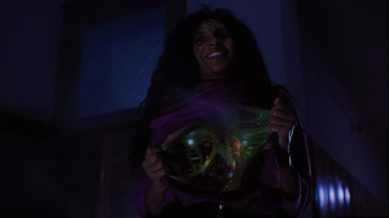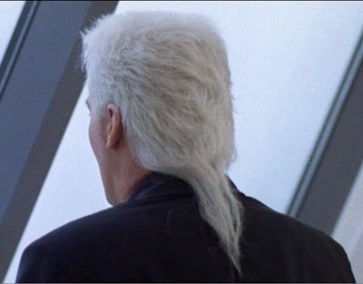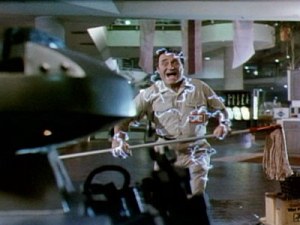Class of 1999
Today’s final entry into Killer Robot Week is “Class of 1999,” a film about a team of cyborg teachers cracking down in an unruly, seemingly post-apocalyptic high school.
“Class of 1999” was written and directed by Mark L. Lester, and was envisioned as a follow-up to his 1980 cult film “Class of 1984.” Lester is best known for his extensive work in action and horror movies, in particular “Firestarter” and “Commando.” Recently, Lester appears to be focusing more on the producing side of B-movies, doing work on such films as “Dragon Wasps,” “Toxin,” “Dragons of Camelot,” and “Poseidon Rex.”
The executive producer on “Class of 1999” is the somewhat infamous Lawrence Kasanoff, who is known for producing such B-films as “Blood Diner,” “Chud II,” and both “Mortal Kombat” films. However, his most recent abhorrent credit is as both writer and director on 2012’s “Foodfight!,” one of the most abysmal films released in years, and perhaps the worst animated feature of all time.
Mark Irwin, the cinematographer on “Class of 1999,” has had a significant career working on a wide range of features. He has credits on well-regarded films such as “The Fly,” “Scanners,” “The Dead Zone,” “Scream,” and “Robocop 2,” but has also had some less-than-lauded works: “Deck the Halls,” “Big Momma’s House 2,” “The Last Godfather,” and “Super Buddies.” He is still active today, and his most recent notable credit is on the Adult Swim show “Black Jesus.” However, the rest of his recent credits lead me to believe that he’ll be working on Tyler Perry productions before too long.
The cast of “Class of 1999” includes a number of well-regarded character actors, led most notably by Malcolm McDowell (“A Clockwork Orange,” “Time After Time,” “Caligula”) and Pam Grier (“Jackie Brown,” “Coffy”). The rest of the cast includes Stacy Keach (“American History X”), John P. Ryan (“It’s Alive,” “Bound”), and Patrick Kilpatrick (“Minority Report,” “Eraser”). Given the setting of a high school, the lead roles in the film were given to younger, less experienced actors: Traci Lind, who popped up in a handful of movies (“Bugsy,” “My Boyfriend’s Back”) afterwards before falling off of the screen in the late 1990s, and Bradley Gregg, who has recently resurfaced after only a handful of credits in the new millennium.
 The story of “Class of 1999” takes place in the distant future of 1999, in which numerous major cities have been overrun by drug-addled youth gangs. In an attempt to salvage the public schools in these areas, the “Department of Educational Defense” pilots a program to use robotic teachers to run classes in the most hostile school environments. The plot follows a handful of students at the first school to use these robot teachers, and shows the robots’ violent decline as their programming (of course) begins to go awry.
The story of “Class of 1999” takes place in the distant future of 1999, in which numerous major cities have been overrun by drug-addled youth gangs. In an attempt to salvage the public schools in these areas, the “Department of Educational Defense” pilots a program to use robotic teachers to run classes in the most hostile school environments. The plot follows a handful of students at the first school to use these robot teachers, and shows the robots’ violent decline as their programming (of course) begins to go awry.
The film portrays school violence, drug use, and gang activity amplified to an absolute maximum, which fits with the generally over-the-top tone and concept of the film. The robot teachers, in contrast, are designed on very traditional stereotypes, and instantly clash with the student body. This, of course, results in a significant amount of friction, which culminates in the liberal use of flamethrowers and high explosives on school grounds in a grand showdown of a conclusion.
 “Class of 1999” currently holds a 5.7 rating on IMDb, as well as a 52% audience score on Rotten Tomatoes. That doesn’t look so great, but you can only expect so much of a positive reaction to this sort of B-movie. BoxOfficeMojo.com reports that the movie’s total gross was just under 2.5 million, but I’ve found estimate that put the budget at well above 5 million, making it an overall financial loss. Despite all of this, the movie bizarrely received a direct-to-video sequel, “Class of 1999 II,” in 1994, without the involvement of Mark Lester.
“Class of 1999” currently holds a 5.7 rating on IMDb, as well as a 52% audience score on Rotten Tomatoes. That doesn’t look so great, but you can only expect so much of a positive reaction to this sort of B-movie. BoxOfficeMojo.com reports that the movie’s total gross was just under 2.5 million, but I’ve found estimate that put the budget at well above 5 million, making it an overall financial loss. Despite all of this, the movie bizarrely received a direct-to-video sequel, “Class of 1999 II,” in 1994, without the involvement of Mark Lester.
For me, the most memorable aspect of “Class of 1999” are the hammy performances by the assorted villains. The robotic teachers, for instance, are constantly dropping one-liners, almost as if it was written into their programming. Perhaps even better than the teachers themselves is their overseer, Dr. Forrest, played by Stacy Keach. His constant leering and over-the-top menacing presence is only outshone by his bizarre appearance in the movie. Just take a look at this guy:


 You can’t do much better than that.
You can’t do much better than that.
Something that I never quite understood about the concept of “Class of 1999” is why a group of kids in an officially lawless territory bothered to show up to a public school at all. There isn’t anything binding them to the school, and the students seem to flow in and out of the classes without aim anyway. Also, if the area is deemed too dangerous for police, then why is the government still putting teachers at risk to keep a public school open in the dead center of the area? It just doesn’t quite make sense to me.
 For a movie released in 1990, “Class of 1999” may seem notably (and unrealistically) pessimistic about the near future. It is worth keeping in mind the context of the time: 1989-1990 was arguably the height of anti-drug panic, anxiety over a perceived rise of violence in schools, and public fears about gang violence. “Class of 1990” hones in on all of these fears, and inflates them as much as possible to create a dramatic (and perhaps ridiculous) vision of a worst-case-scenario for the new millennium.
For a movie released in 1990, “Class of 1999” may seem notably (and unrealistically) pessimistic about the near future. It is worth keeping in mind the context of the time: 1989-1990 was arguably the height of anti-drug panic, anxiety over a perceived rise of violence in schools, and public fears about gang violence. “Class of 1990” hones in on all of these fears, and inflates them as much as possible to create a dramatic (and perhaps ridiculous) vision of a worst-case-scenario for the new millennium.
In the opening sequence of “Class of 1999,” while a robotic voice over is laying out the background for the story, a map pops up on screen showing the major urban areas in the United States that have been overrun by gangs. It might be a bit of a minor detail, but I couldn’t help but notice how dramatically misplaced Cleveland is. Check it out:
For those who might not be aware, Cleveland is on the shore of Lake Erie, on the northern boundary of Ohio: I decided to check out Google Maps to see where Cleveland had been relocated to in this outlandishly depressing vision of 1999, and the closest place I could come up with is a small town called Cambridge, OH. Last I checked, Cleveland has not yet moved there in reality, though, but let’s keep our eyes peeled on that.
I decided to check out Google Maps to see where Cleveland had been relocated to in this outlandishly depressing vision of 1999, and the closest place I could come up with is a small town called Cambridge, OH. Last I checked, Cleveland has not yet moved there in reality, though, but let’s keep our eyes peeled on that.
Something that is impossible not to note in “Class of 1999” is that it, along with countless other killer robot films, uses the same explanation for the robot’s sinister behavior. As with “Small Soldiers,” “Red Planet,” and “Evolver,” the teachers in “Class of 1999” are re-purposed military prototypes that revert to their original field programming. It isn’t necessarily a bad way to set up the background for the robots, but it has clearly been done now. I can’t particularly blame “Class of 1999” for this, given it was made in 1990, but writers of potential robot flicks should probably take note of how often this mechanic has already been used.
Overall, “Class of 1999” is a fun, good-bad flick. The acting is perfectly over-the-top, the premise and setting is ludicrous, and the deaths and effects certainly don’t disappoint. If you are looking for a bad movie to watch with friends, this is one worth putting on your list.
—-
Alas, with “Class of 1999,” Killer Robot Week has finally come to an end. So, here are some final thoughts.
First off, there are lots of fun killer robot movies out there. I only just started to scratch the surface with Killer Robot Week. I’m sure that there are plenty more robot movies out there that I don’t know anything about at all.
However, I couldn’t help but notice that there hasn’t been much in the way of high profile killer robot movies in recent years, outside of “Transformers” movies, bad “Terminator” sequels, and that wholly unnecessary recent RoboCop reboot. Killer robots seem to have been sidelined in recent years, which is a bit of a shame.
2015, however, is going to be a Killer Robot renaissance: I can just feel it. High profile films like “Chappie,” “Avengers: Age of Ultron,” and “Terminator: Genisys” are bringing mechanized marauders back to the forefront of cinema in a big way, and if history tells us anything, imitation flicks will be right on their heels. In other exciting news, even BattleBots is coming back! Surely, these are signs of a bright future for our eventual robot overlords.
I’m looking forward to perhaps some more cerebral robot movies in coming years, incorporating the current popular anxieties over AI, the increased use of robotics for violence, and the arguably alarmingly rapid improvements in technology across the board in society. In a time of drones and practical robotics, now is the best time ever to see a real renaissance of robot and AI movies in general. Particularly in the horror genre, the best stories play on popular subliminal fears, which can often be pulled straight from the headlines. Just looking around, it seems to me that the Time of the Machines (for horror, anyway) is now. We live in a world that is increasingly dependent on technology, but still harbors significant luddite fears about our surroundings and our collective future. Here’s hoping someone can take advantage of all of this, and create some fantastic robot movies over the next few years.
Or, y’know, more vapid, fun killer robot movies couldn’t hurt either. I’d be ok with more of those, too.
If you want to catch up on the previous movies covered on Killer Robot Week, you can check them out here:
![Misan[trope]y](https://misantropey.files.wordpress.com/2014/10/misantropeyhead1.png)
























